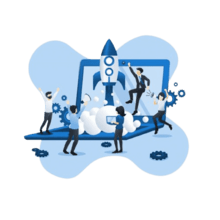Mastering Go-to-Market Motions to Drive Business Growth

As the CEO of O8, a digital agency specializing in driving measurable growth for marketing and sales teams, I've seen firsthand the transformative power of well-executed go-to-market (GTM) motions. In a world where 80% of companies face buying committees with up to 22 distinct roles, having a robust and adaptable GTM strategy can make all the difference (Source).
Go-to-market motions are the strategic actions a company takes to bring its products to market and connect with customers. These motions are crucial for aligning your product with the right market, optimizing sales processes, and ultimately driving revenue.
According to a report by the Go-to-Market Alliance, only 25.6% of companies describe their culture as sales-first, which highlights how many businesses struggle with cultural alignment in their GTM strategies (Source). Moreover, 68% of marketers acknowledge the direct impact of their GTM strategy on achieving revenue goals (Source).
However, choosing the right GTM motion for your business can be challenging. The buying process, cultural alignment, and selecting the appropriate approach to meet your goals can be daunting.
- Complex buying processes often involve numerous stakeholders, making it essential to have a well-coordinated GTM motion.
- Many companies face cultural misalignment, with their teams not always on the same page regarding sales and marketing priorities.
- Identifying the most effective GTM motion for your product and market can be difficult, but it is necessary for driving growth and achieving revenue targets.
Understanding and implementing the right GTM motions can set your business on a path to success. This blog post aims to provide actionable insights into various GTM motions, helping you choose the best strategies to reach your target audience and achieve sustainable growth.
Go-to-Market Motions: An Overview
What Are Go-to-Market Motions?
Go-to-market (GTM) motions are strategic approaches that companies utilize to bring their products to market and connect with customers effectively. These motions are tailored to align with a company's product, market, and customer needs, ensuring that the product reaches the right audience through the most effective channels. By selecting the appropriate GTM motion, businesses can optimize their sales processes, improve customer engagement, and ultimately drive revenue growth.

In a competitive landscape, understanding and leveraging the right GTM motions can be the difference between success and failure. Whether your business is in its startup phase or an established enterprise, having a clear GTM strategy is essential for sustaining growth and achieving your revenue goals. Read More
Types of GTM Motions
Different businesses require unique approaches to effectively reach their target markets. Here’s an overview of some common GTM motions:
Product-Led Growth (PLG)
Product-led growth focuses on using your product as the primary driver of customer acquisition, expansion, and retention. This strategy is highly effective for SaaS companies and startups that offer innovative and user-friendly products.
Examples include:
- Freemium Model: Offering a free version of your product with limited features, encouraging users to upgrade to premium versions for additional functionality.
- Free Trials: Allowing potential customers to use your product for free for a limited time to demonstrate its value.
- Self-Service Onboarding: Designing a seamless onboarding process that enables users to get started quickly without the need for sales intervention.
Sales-Led Growth
Sales-led growth relies heavily on a direct sales approach to engage with potential customers. This strategy is often used for high-ticket items or complex sales processes.
Methods include:
- Inside Sales: Utilizing an inside sales team to handle lead generation, qualification, and closing deals remotely through calls and emails.
- Field Sales: Employing a field sales team to meet with potential customers in person, especially for complex sales.
- Channel Sales: Partnering with resellers, distributors, or agents who can sell your product to their customer base.
Marketing-Led Growth
Marketing-led growth leverages comprehensive marketing strategies to attract and convert leads. This approach is particularly effective for B2B SaaS companies and enterprises looking to scale their marketing efforts.
Strategies include:
- Inbound Marketing: Attracting and nurturing leads through content marketing, SEO, social media, and email marketing. Learn more about our inbound marketing services.
- Outbound Marketing: Actively reaching out to potential customers through targeted advertising, email campaigns, and direct mail.
- Account-Based Marketing (ABM): Focusing marketing efforts on a select group of high-value accounts, creating personalized campaigns to win their business.
Partner-Led Growth
Partner-led growth involves forming strategic alliances to expand your market reach. This approach can be particularly advantageous for companies looking to leverage the strengths and customer bases of their partners.
Approaches include:
- Strategic Alliances: Forming alliances with other companies to co-market and co-sell products.
- OEM (Original Equipment Manufacturer) Partnerships: Integrating your product into another company's offering.
- Referral Programs: Encouraging existing customers or partners to refer new business to you in exchange for incentives.
Customer-Centric Growth
Customer-centric growth focuses on putting the customer at the heart of your strategy. This includes ensuring customer success, building communities, and continuously improving customer experiences based on feedback.
Techniques include:
- Customer Success Programs: Developing programs focused on ensuring your customers achieve their desired outcomes, leading to higher retention and upsell opportunities.
- Community Building: Creating and nurturing a community around your product or brand to foster loyalty, engagement, and advocacy.
- Customer Feedback Loops: Continuously gathering and acting on customer feedback to improve your product and customer experience.
Developer-Led Growth
Developer-led growth emphasizes engaging the developer community to drive product adoption and advocacy. This approach is highly effective for tech companies offering APIs and developer tools.
Components include:
- API-First Approach: Building your product with a strong emphasis on APIs, enabling developers to integrate and extend your product’s functionality easily.
- Developer Evangelism: Engaging with the developer community through events, hackathons, and online forums.
- Technical Content: Providing extensive technical documentation, tutorials, and resources to help developers get the most out of your product.
Hybrid Motions
Hybrid motions combine elements from multiple GTM strategies to create a more versatile approach. This can be particularly beneficial for businesses in dynamic markets where a single strategy may not suffice.

Examples include:
- Integrated Sales and Marketing: Aligning sales and marketing teams to work together seamlessly, ensuring consistent messaging and efficient lead handoff.
- Product and Sales Collaboration: Combining product-led growth with a dedicated sales effort to guide potential customers through the purchasing journey.
- Multi-Channel Approach: Using a mix of direct sales, channel partners, and online self-service options to reach different customer segments effectively.
Next, we'll look at a detailed breakdown of GTM motions.
Detailed Breakdown of GTM Motions
Sales-led growth focuses on driving revenue through proactive sales strategies and direct customer engagement, whereas product-led growth emphasizes leveraging the product itself to attract, retain, and convert users into paying customers. First, let's look at product-led growth.
Product-Led Growth (PLG)
Product-led growth (PLG) is a strategy where the product itself is the primary driver of customer acquisition, retention, and expansion. This approach works exceptionally well for SaaS companies that can leverage their product's usability and value to attract and retain customers. Here are a few examples:
- Freemium Model: Offering a free version of your product with basic features, enticing users to upgrade to a premium version to access advanced functionalities. For instance, companies like Slack and Trello have successfully implemented this model to increase user adoption and drive revenue.
- Free Trials: Allowing potential customers to use your product for free for a limited time can effectively demonstrate its value. According to research, companies offering free trials see a significant increase in customer acquisition rates (Source).
- Self-Service Onboarding: Designing an intuitive and seamless onboarding process helps users get started quickly without needing sales intervention. This approach is critical for reducing friction and enhancing user experience.
When the product itself isn't doing the selling, you may need sales-led growth.
Sales-Led Growth
Sales-led growth relies on direct sales efforts to engage and convert potential customers. This strategy is often employed for high-ticket items or complex products that require personalized attention and relationship building.

- Inside Sales: Inside sales teams focus on lead generation, qualification, and closing deals remotely through calls, emails, and virtual meetings. This method is cost-effective and allows sales teams to reach a broader audience.
- Field Sales: Field sales teams meet with potential customers in person, which is particularly effective for high-ticket or complex sales. By building face-to-face relationships, field sales teams can better understand customer needs and tailor their pitches accordingly.
- Channel Sales: Partnering with resellers, distributors, or agents to extend your product's reach. Channel sales allow businesses to leverage the expertise and customer base of their partners, thus expanding market reach without significant investment in direct sales resources.
Marketing-led growth drives revenue by creating awareness, generating demand, and nurturing leads through strategic marketing campaigns and content. In contrast, sales-led growth relies on direct customer interaction, personalized outreach, and closing deals through a proactive sales team. Both aim to increase revenue, but marketing-led growth focuses on broad reach and lead generation, while sales-led growth emphasizes personal connection and deal closure.
Marketing-Led Growth
Marketing-led growth leverages comprehensive marketing strategies to attract, convert, and retain customers. This approach is crucial for building brand awareness and generating leads through various channels.
- Inbound Marketing: Inbound marketing involves attracting and nurturing leads through content marketing, SEO, social media, and email marketing. By providing valuable content that addresses customer pain points, businesses can build trust and authority. Learn more about our inbound marketing services.
- Outbound Marketing: Outbound marketing entails proactively reaching out to potential customers through targeted advertising, email campaigns, and direct mail. This strategy can be effective for generating immediate responses and driving short-term sales.
- Account-Based Marketing (ABM): ABM focuses marketing efforts on a select group of high-value accounts, creating personalized campaigns to win their business. This approach is especially effective for B2B companies aiming to secure large, strategic clients.
Marketing-led growth focuses on creating awareness and generating demand through strategic marketing efforts, while partner-led growth leverages collaborations with external partners to drive revenue and expand reach. Both approaches aim to grow the business, but marketing-led growth is driven by internal campaigns, whereas partner-led growth relies on external relationships.
Partner-Led Growth
Partner-led growth involves forming strategic alliances to expand market reach and leverage partner strengths. This approach can significantly enhance your company's capabilities and customer base.
- Strategic Alliances: Forming partnerships with other companies to co-market and co-sell products. This collaboration can lead to increased market penetration and shared resources. For example, O8 has successfully partnered with various industry leaders to offer comprehensive digital marketing solutions.
- OEM Partnerships: Integrating your product into another company's offering can expand your reach and market presence. OEM partnerships are beneficial for companies looking to embed their solutions into existing products or services.
- Referral Programs: Encouraging existing customers or partners to refer new business in exchange for incentives. Referral programs can be a cost-effective way to generate high-quality leads and increase customer acquisition.
Partner-led growth relies on external partnerships to drive revenue and expand reach, while product-led growth uses the product itself to attract and retain customers. Customer-centric growth, on the other hand, focuses on deeply understanding and addressing customer needs and preferences to build loyalty and long-term relationships. While partner-led and product-led growth strategies prioritize external collaborations and product features respectively, customer-centric growth places the customer at the core of all business decisions and strategies.
Customer-Centric Growth
Customer-centric growth places the customer at the center of the business strategy, focusing on delivering exceptional experiences and outcomes. This approach can significantly enhance customer loyalty and drive long-term growth.
- Customer Success Programs: Developing programs aimed at ensuring customers achieve their desired outcomes can lead to higher retention rates and upsell opportunities. Effective customer success programs involve regular check-ins, proactive support, and tailored solutions.
- Community Building: Creating and nurturing a community around your product or brand fosters loyalty, engagement, and advocacy. Communities can serve as a platform for customers to share feedback, seek support, and connect with like-minded individuals.
- Customer Feedback Loops: Continuously gathering and acting on customer feedback to improve your product and customer experience is crucial. Implementing robust feedback loops helps businesses identify pain points, innovate, and enhance customer satisfaction.
Customer-centric growth focuses on understanding and addressing the needs and preferences of customers to build loyalty and long-term relationships. Developer-led growth, in contrast, emphasizes empowering developers to drive product adoption and innovation by creating tools, APIs, and platforms that developers love and integrate into their work. While customer-centric growth prioritizes the overall customer experience and satisfaction, developer-led growth targets the developer community to drive product usage and expansion through technical engagement and advocacy.
Developer-Led Growth
Developer-led growth emphasizes engaging the developer community to drive product adoption and advocacy. This approach is particularly effective for tech companies offering APIs and developer tools.
- API-First Approach: Building your product with a strong emphasis on APIs enables developers to integrate and extend your product’s functionality easily. Companies like Twilio and Stripe have leveraged this approach to become industry leaders.
- Developer Evangelism: Engaging with the developer community through events, hackathons, and online forums can drive product adoption and advocacy. Developer evangelists play a crucial role in fostering community engagement and showcasing product capabilities.
- Technical Content: Providing extensive technical documentation, tutorials, and resources helps developers get the most out of your product. High-quality technical content can reduce support overhead and accelerate developer onboarding.
Hybrid go-to-market (GTM) motions combine multiple strategies, such as sales-led, marketing-led, and product-led approaches, to create a flexible and comprehensive market entry plan. A single-motion approach, on the other hand, focuses exclusively on one strategy, like sales-led growth, product-led growth, etc. While hybrid GTM motions provide adaptability and can leverage the strengths of various strategies, a single-motion approach offers simplicity and concentrated efforts on a specific growth path.
Hybrid Motions
Hybrid motions combine elements from multiple GTM strategies to create a versatile and comprehensive approach. This flexibility can be particularly beneficial for businesses operating in dynamic markets.
- Integrated Sales and Marketing: Aligning sales and marketing teams to work together seamlessly ensures consistent messaging and efficient lead handoff. This integration can lead to more effective campaigns and higher conversion rates.
- Product and Sales Collaboration: Combining product-led growth with a dedicated sales effort can guide potential customers through the purchasing journey more effectively. This collaboration ensures that both the product and sales teams are aligned in their goals.
- Multi-Channel Approach: Using a mix of direct sales, channel partners, and online self-service options allows businesses to reach different customer segments effectively. This diversified approach can maximize market penetration and customer engagement.
Growth strategies vary in focus, from product-led and sales-led approaches to marketing-led, partner-led, customer-centric, and developer-led growth, each leveraging unique strengths to drive business expansion. Hybrid go-to-market motions combine elements of these strategies, offering flexibility and a comprehensive approach for dynamic markets.
Choosing the Right GTM Motion
Assessing Your Business Needs and Target Market
Selecting the right go-to-market (GTM) motion for your business requires a thorough assessment of your unique needs, target market, and overall business goals. A one-size-fits-all approach won't suffice; instead, you need a tailored strategy that aligns with your product, customer profile, and company culture.
Factors to Consider
- Product Type
- The nature of your product plays a significant role in determining the most effective GTM motion. For instance, SaaS companies may benefit from product-led growth (PLG) strategies, whereas enterprises offering complex solutions might lean towards sales-led motions.
- Customer Profile
- Understanding your ideal customer profile (ICP) is crucial. Analyze their needs, pain points, and buying behaviors to choose a GTM strategy that resonates with them. For example, a B2B SaaS company targeting large enterprises may find account-based marketing (ABM) more effective.
- Company Culture
- Your internal culture and strengths should guide your GTM strategy. If your team excels in building customer relationships, a sales-led motion could be ideal. Conversely, if your product is intuitive and drives engagement independently, a product-led approach may be more suitable.
Key Metrics for Evaluating GTM Motions
Measuring the success of your chosen GTM motion involves tracking specific metrics that align with your business goals. Here are some critical metrics to consider:
Customer Acquisition Cost (CAC)
- The total cost of acquiring a new customer, including marketing and sales expenses. Evaluating CAC helps determine the cost-effectiveness of your GTM motion.
Lifetime Value (LTV)
- The total revenue generated by a customer over their lifetime with your company. Comparing LTV with CAC provides insights into the long-term viability of your GTM strategy.
Conversion Rate
- The percentage of leads that convert into paying customers. Tracking conversion rates at different stages of the customer journey helps identify bottlenecks and optimize your GTM motion.
Customer Retention Rate
- The percentage of customers who continue to use your product or service over a specified period. High retention rates indicate the effectiveness of customer-centric growth and customer success programs.
Sales Cycle Length
- The average time it takes to convert a lead into a paying customer. Shortening the sales cycle can improve efficiency and accelerate revenue growth.
Strategies for Optimizing GTM Motions for New Product Launches
Launching a new product requires a well-coordinated GTM strategy that addresses potential challenges and maximizes market impact. Here are some actionable tips:
- Market Research
- Conduct thorough market research to understand customer needs, competitor offerings, and market trends. This data-driven approach informs your GTM strategy and helps identify opportunities for differentiation.
- Align Product and Sales Teams
- Ensure that your product and sales teams are aligned in their goals and messaging. Regular communication and collaboration between these teams can lead to more effective GTM execution.
- Leverage Early Adopters
- Identify and engage with early adopters who can provide valuable feedback and serve as advocates for your new product. Offering exclusive incentives or early access can attract these key customers.
- Create a Compelling Value Proposition
- Clearly articulate the unique value your product offers to potential customers. Highlight how it addresses their pain points and delivers specific benefits that competitors do not.
- Implement Scalable Marketing Campaigns
- Develop marketing campaigns that can scale with the growth of your product. Utilize a mix of inbound and outbound marketing strategies to reach a broader audience and generate leads.
- Utilize Customer Feedback Loops
- Continuously gather and act on customer feedback to refine your product and improve the customer experience. Implementing feedback loops ensures that your product evolves to meet customer needs.
Conclusion
Choosing the right go-to-market (GTM) motions can significantly impact your company's ability to reach and resonate with your target audience. Whether you lean towards product-led, sales-led, marketing-led, partner-led, customer-centric, developer-led, or hybrid approaches, the key is aligning your strategy with your business needs, customer profiles, and market conditions.
By understanding the different GTM motions and their applications, you can make informed decisions that drive measurable growth. For instance, if you are a SaaS company targeting a broad market, a product-led growth strategy with a freemium model and self-service onboarding might be highly effective. On the other hand, if you offer complex, high-ticket solutions, a sales-led approach with a combination of inside and field sales could better serve your needs.
The importance of measuring and optimizing your GTM motions cannot be overstated. Key metrics such as customer acquisition cost (CAC), lifetime value (LTV), conversion rates, customer retention rates, and sales cycle length provide valuable insights into the effectiveness of your strategy. Regularly reviewing these metrics allows you to make data-driven adjustments that enhance performance and align with your business goals.
For new product launches, consider leveraging market research, aligning product and sales teams, engaging early adopters, and creating compelling value propositions. Implementing scalable marketing campaigns and utilizing customer feedback loops are also critical for refining your product and enhancing customer experience.
At O8, we specialize in helping businesses navigate the complexities of the digital landscape with customized, data-driven approaches. Whether you're looking to optimize your current GTM strategy or explore new avenues for growth, our team of experts is here to provide the guidance and support you need to succeed.
Explore our services and discover how our expertise in go-to-market strategies, inbound marketing, and customer success can drive measurable growth for your business. Contact us today to learn more.

















